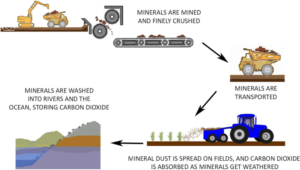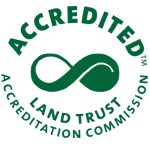Enhanced weathering (EW) involves spreading finely ground rock particles, often silicate rocks like basalt, to increase the rate of weathering and facilitate carbon dioxide removal. It is a type of geoengineering (learn more about geoengineering here) that can address climate change by providing carbon capture and storage. EW can also address sustainable agriculture via carbon capture and storage, as well as via potential improvement of soil fertility. EW may have potential to be part of an overall strategy for mitigation of climate change.
What is Enhanced Weathering?
Enhanced weathering is a carbon capture technology that accelerates natural weathering processes (i.e., the chemical and physical breakdown of rocks) to remove carbon dioxide (CO₂) from the atmosphere. The silicate rock weathering reacts with CO₂, converting it into bicarbonate ions, leading to carbon sequestration. Enhanced rock weathering can be deployed on croplands, offering the dual benefits of CO₂ removal and potential improvement of soil fertility. The technology increases ocean and river alkalinity by depositing rock particles into rivers and oceans, contributing to carbon capture efforts. By extracting carbon from the air and storing it in rocks, EW is considered a strategy to address climate change.

Source of Picture: Remineralize the Earth
In addition, EW is considered a regenerative farming practice as it aligns with regenerative principles by addressing environmental challenges and promoting sustainability. By applying crushed rock materials to agricultural soils, enhanced weathering captures carbon, mitigating climate change effects. The process aids in climate change impacts by removing CO₂ from the atmosphere, fitting seamlessly into a regenerative farming model. EW not only contributes to carbon removal, but also enhances agricultural productivity through increased resource efficiency and soil recovery.
Prior to applying the materials to the soil, the minerals are mined, crushed into a fine texture, and then transported to their point of use. This pre-processing is a point of concern as discussed later.

Source of Picture: Climatic Change Journal
What are the benefits and challenges of Enhanced Weathering?
EW has the potential for large-scale carbon dioxide removal. EW reduces the timescale of weathering from millions of years to decades. Once the reaction between CO₂ and the weathered rock takes place, it is very difficult to reverse. The CO₂ stays locked away for hundreds of thousands of years, or, as far as humans are concerned, permanently.
EW also scales up the process of bicarbonate washing into rivers and oceans, where the carbon is stored in dissolved form for hundreds of thousands of years or locked up on the sea floor.
It faces challenges, however, including the high energy demands of pulverizing rocks and understanding the full impacts of adding silicates to soils and oceans under real-world conditions. The rock powder used for enhanced weathering may have impacts on human health if it is breathed in, especially because some rocks contain toxic compounds like asbestos. There is also the risk that heavy metals from the rocks could end up in food crops. More research is needed in these areas to better understand any unintended consequences.
Quantifying EW’s carbon-capture potential has also been a challenge. However, in a recent news release, the Institute for Sustainability, Energy, and Environment (iSEE) at the University of Illinois, announced that it has been able to calculate both the weathering rate and carbon dioxide reduction potential of the basalt rock amendments applied to maize and miscanthus fields. Those factors are critical for efforts to optimize carbon sequestration and for farmers hoping to earn carbon credits to help with farm profitability.
What is The Conservation Foundation’s viewpoint on Enhanced Weathering?
The Conservation Foundation’s mission is to improve the health of our communities by preserving and restoring natural areas and open space, protecting rivers and watersheds, and promoting stewardship of our environment. In that regard, our efforts help mitigate climate change. We believe that “Land Conservation is Climate Action” as expressed by Andrew J. Bowman in his Saving Land Magazine Winter 2024 article.
The Conservation Foundation is a leader in sustainable farming. In its own McDonald Farm in Naperville, The Conservation Foundation uses organic farming land-management practices to improve soil health, biodiversity, and climate resilience.
The Conservation Foundation is a recognized expert and reasoned voice on conservation issues and, with the help of its members and donors, provides the leadership required to achieve this vision. The Conservation Foundation provides a forum for the discussion of ideas – even those we may not 100% support or are still in the “too early to say” stage. It’s always good to be aware of emerging technologies.
There are concerns about the costs and climate effects of mining and transportation involved. Food safety and human health effects certainly need to be further analyzed. And profitability for farmers must be addressed for EW to be implemented at scale for agriculture.
Land conservation and EW are both addressing the problem of climate change. They are two parts of an overall strategy to mitigate the negative impacts of climate change, create healthier communities, and improve the resiliency of ecosystems. As EW practices develop, it may have the potential to address climate change.
Ready to support conservation and maybe even do a little enhanced weathering? Well, conservation is what The Conservation Foundation has been doing every day for more than 50 years. We can all do more together than we can alone. Join our collective momentum – become a member today!
Feel free to comment on this blog with your ideas on enhanced weathering.
By Steve Stawarz, Oak Brook
DuPage County Advisory Council Member



